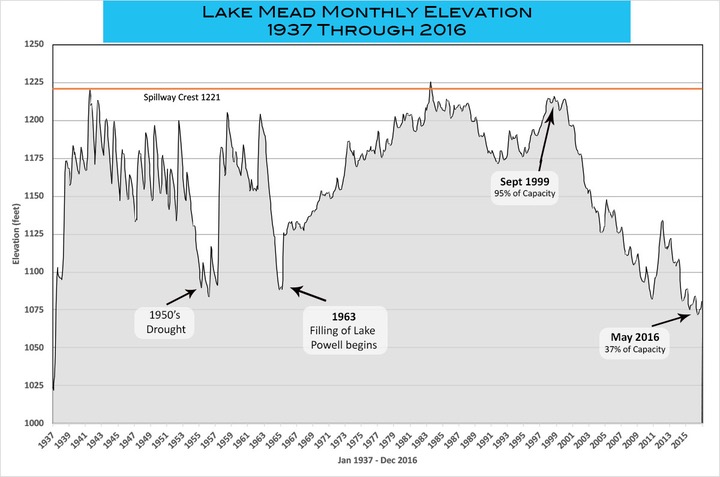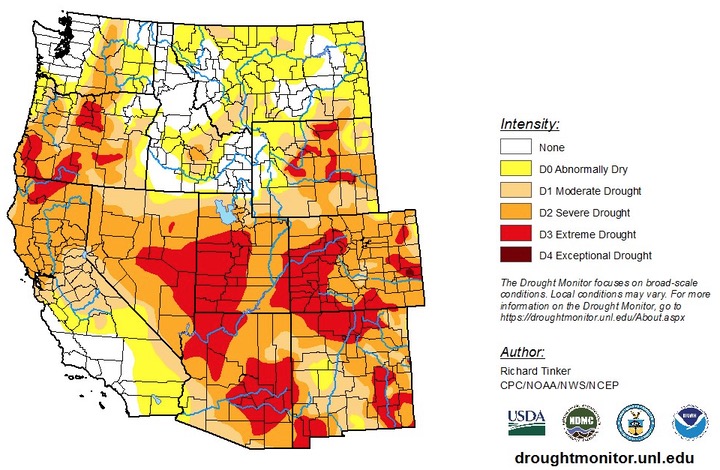Disclosure: Although I currently serve as a volunteer on the San Juan Water Conservancy District board, the following editorial expresses my personal opinions, and not necessarily the opinions of anyone else on the SJWCD board, nor of the board as a whole.
Based on my limited research into the issue, there are four main reasons for building dams like the Hoover Dam, the dam that created America’s largest reservoir, Lake Meade.
In no particular order of importance:
- Flood control
- Generation of hydroelectricity
- Creation of artificial water storage to promote the growth of agriculture and population
- Giving federally-funded engineers and construction companies something to do for a few years
The drawbacks to building a dam like Hoover Dam become evident many years — even decades — later.
One of the drawbacks is “evaporation.”
We discussed, in Part Three of this editorial series, the troubles facing the agricultural industry in the San Luis Valley, on the other side of Wolf Creek Pass, where farmers have been depleting the underground aquifer through excessive irrigation, in spite of attempts, in recent years, to solve the problem. It appears that the farmers will need to make more drastic measures — or else, have more drastic measures imposed upon them by the state government.
It’s not exactly a “lack of water”. It’s more a matter of “abusing the aquifer”… too many farmers, believing that San Luis Valley water was an inexhaustible resource, pumping too much water.
Building a water reservoir — a big lake — in the middle of the San Luis Valley, and pumping water out of its already-over-allocated underground aquifer to try and keep the reservoir full, would be a really crazy idea.
And honestly, no one has ever suggested such an idea.
But people have suggested ideas that, on the face of it, may have been just as crazy. Some of these people have been employed by the US Bureau of Reclamation, and many years ago, the engineers and bureaucrats at USBR determined that the American West could develop a massive agricultural industry if the “excess” water flowing down the Colorado River (and its tributaries) could be corralled in enormous lakes instead of flowing unused into Mexico (where it had been flowing, in a wasteful manner, for centuries.) The result of these ideas — augmented by billions of tax dollars — was a number of storage reservoirs within the Colorado River Basin, the largest of which are, in order of magnitude:
- Lake Mead (28.9 million acre feet when full)
- Lake Powell (26.2 million acre feet when full)
- Painted Rock Reservoir (2.5 million acre feet when full)
- Lake Mojave (1.8 million acre feet when full)
- Navajo Lake (1.7 million acre feet when full)
- Lake Pleasant (1.1 million acre feet when full)
- Blue Mesa Reservoir (0.9 million acre feet when full)
USBR has built more than 30 major reservoirs within the Colorado River Basin. You can view a partial list here. If you add up the peak storage capacity of all the reservoirs within the Colorado River Basin, they appear capable of storing four times the average flow of the Colorado and its tributaries.
All water sources are limited. But some appear to be inexhaustible… if you don’t look too far into the future. The San Luis Valley aquifer appeared, at times in the past, to be bottomless. There seemed to be no limit to the number of farms that could be accommodated, or to the types of water-thirsty crops that could be grown there.
When the Bureau of Reclamation finished building the Hoover Dam in 1935 — an effort that cost $860 million (2020 dollars) and 112 lives — and began to fill Lake Mead, the future looked bright. By the winter of 1941, the reservoir was full. As the years went by the lake level fluctuated, dropping to a frighteningly low level during a drought in the 1950s.
But the reservoir level has steadily dropped since about 2001, and it’s now near its lowest level in its 75 year history: 40% of capacity. The lake is only about 5 feet higher than it was two summers ago, during the 2018 drought, in spite of a surprisingly wet 2019. But when a reservoir threatens to run dry — like when an underground aquifer threatens to run dry — the real problem is not so-called “drought”. The real problem is too many people drawing on the water.
Here’s a three-minute video on the subject.
Federal government numbers show Lake Powell — the nation’s second largest reservoir, along the Arizona-Utah border, also fed by the Colorado River — now sitting 50% full.
Projections show that Lake Mead water level will remain within a zone called “Tier Zero” this year, requiring Arizona and Nevada to once again reduce their withdrawals from the reservoir. The data suggests that Lake Mead would have dropped significantly lower, if the seven states that rely on the Colorado River hadn’t reached a shortage-sharing agreement.
Lately, some folks have been pointing to the University of Nebraska “Drought Monitor” maps, and reminding us that ‘climate change’ is very real and the American West is destined to become drier and drier as the years go on.
So I thought I might to do a bit of investigation into the problem of “evaporation.” According to some Internet sources, evaporative losses at Lake Powell were estimated at about 386,000 acre-feet in 2018. That’s roughly 30 percent more water than Nevada is allowed to take from the Colorado River each year.
Evaporative loss estimates for Lake Mead range from about 600,000 acre-feet to as much as 875,000 acre-feet annually.
How much water do we lose to evaporation, from our reservoirs here in Archuleta County? And is it significant?


